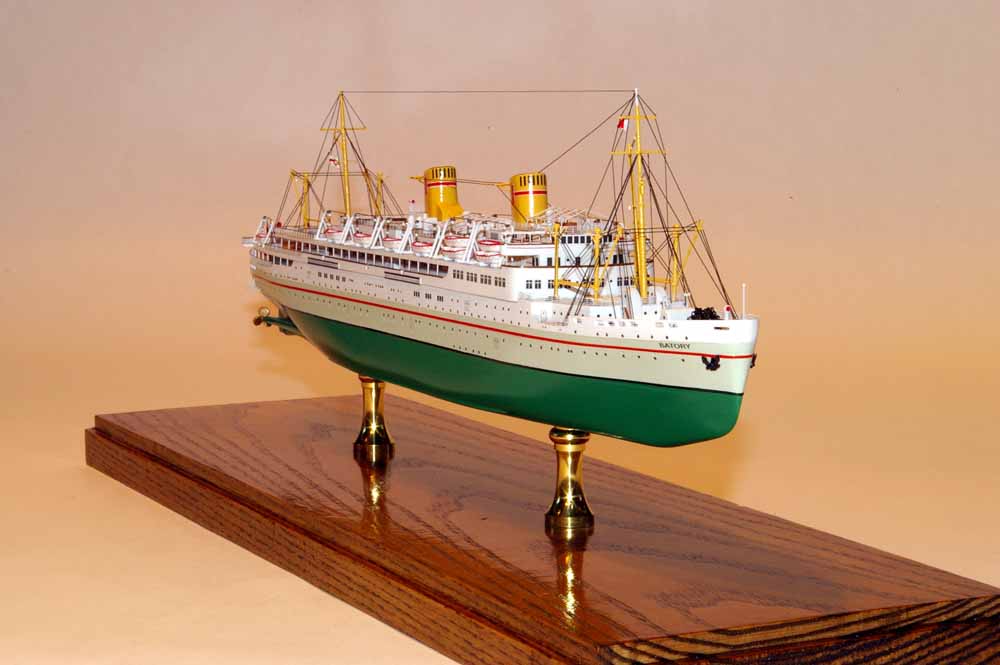by Charles Daigneault

1/500 Polish Liner Batory (Mirage)

Ship modeling is about striving to build models of excellence. But more importantly I think, it is about learning, developing and improving oneís skills. Building Mirageís Batory has been a challenge for me and also, a real learning experience. In this respect, all the hours I spent on this project paid off.
The lesson I learned is: there is never too much planning but very often not enough.
As plastic models go, Batory had two positive points.
1) An interesting subject, a mid 30ís to 50ís medium sized ocean liner
2) No molded on railings.
As for the rest, well, I have to admit that problems started as soon as I opened the box. The hand-drawn instruction sheet was basic and vague, there were numerous broken, missing and incompletely molded parts, no stanchions whatsoever; furthermore, the plastic was extremely brittle- I broke both masts just by touching them with my fingertip. They would never have been able to support rigging of any kind. This was not really a problem as I had planned to replace all these parts anyway. There was much grinding away at overly thick parts, seam filling , sanding and priming before I obtained an acceptable hull and main deck fit. There was something wrong with the length of upper decks, I had to shorten the boat deck to have it fit the superstructure properly. One major defect was the sheer line, or curvature of the upper hull, it was much too accentuated to my liking and in my opinion gave the model a toy-like appearance. Furthermore this part of the hull looked as if someone had carelessly removed chunks of plastic with a kitchen knife, the hull tops were jagged and asymetrical. Also beause the upper decks and molded supersructure were straight, they just would not bend enough to follow this curve leaving two large and ugly seams. I tried to compress them with clamps and large rubber bands but the pressure created strain and kept splitting the hull seam. My plan was to assemble the upper deck and superstructure and finish this unit as much as possible before joining it to the hull, so, this fit had to be as tight as possible. In this respect, I decided to straighten things up with styrene sheet and in the process softening the curve almost to zero which I thought would not have too much consequences, but to my horror, I discovered much later (after all the paint coats were applied of course) that this rather small modification had played havoc with the molded portholes rows.
I also made an error locating the hull color separation line, it is too low, consequently, there is more white in the superstructure compared to the shipís original livery, which gives the model a little top heavy appearence, another error I made in this area is the shape of the front bulwark of the promenade deck, it should be straight and vertical, not curving up, this error crept in when I decided to replace the ill fitting original sanchions part that came with the kit with a thinner one fabricated from styrene. I was surprised to see these errors did not deface the model to much and even looked rather good in the end.. Also, to complicate matters, the decals were unusable, the funnel logos shattered in the water, and I ended making my own , unfortunately and for an unknown reason the white parts of the decal film yellowed a couple of days after application. T he davits kept breaking while I tried to assemble and glue them to the deck and they looked akward so I fabricated new ones from copper wire. Then due to my tampering with the sheer line, the portholes would not follow the hull paint separation lines, I decided to apply decal dots instead. (a technique I plan to use more in the future) My research was limited to grainy photos of Batory and her sister Pilsudski, from the photos, it is obvious the rake of the masts is the same as the funnels, this created interferences with rigging for the masts derrick and kingposts, the vague kitís instructions and scarce photos I found on the web were not much help so I never got this part of the model right. I was very disapointed at my lack of foresight and I felt I was going nowhere, at this point I just wanted to to hide the project on a shelf and forget about it, but I had never abandoned a project before. After much thought, mainly becase I had already put numerous hours in this model but not wanting to start over, I decided to continue with the build anyway and to handle problems one by one, the objective was now to produce if not an exact replica, at least a pleasing model to look at. Taking my inspiration from books and photos of contemporary ocean liners I let my creativity take over and added many scratchbuild details, deckchairs winches, deck awnings etc. I used GMM 1/500 merchant ship etched railings and fabricated a wood base and plexi display case, I recycled brass lamp pull chain ornaments in lieu of pedestals.
Well, here it is, by no means an exact reproduction but I think the result turned out pleasing to the eye and captures the appearance of the ocean liners of this era.
I love visiting the the modelship gallery; it is my favorite web site. I enjoy very much admiring fellow modelerís work, in a way, I feel at home here, for this reason I mustered the courage to share this experience with you.
In retrospect I realise that I approached this build with the idea this was to be a fast and easy project, and as we all know, it never is.
